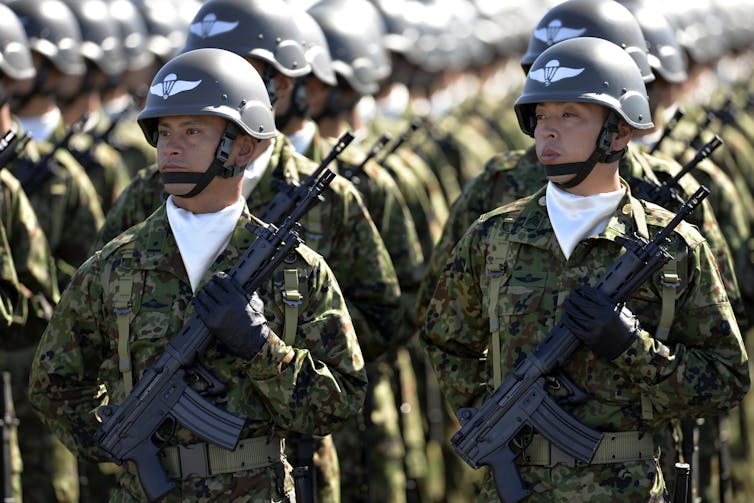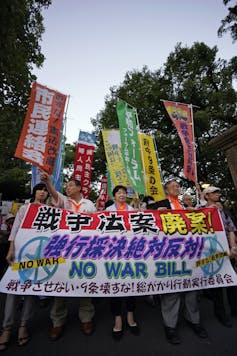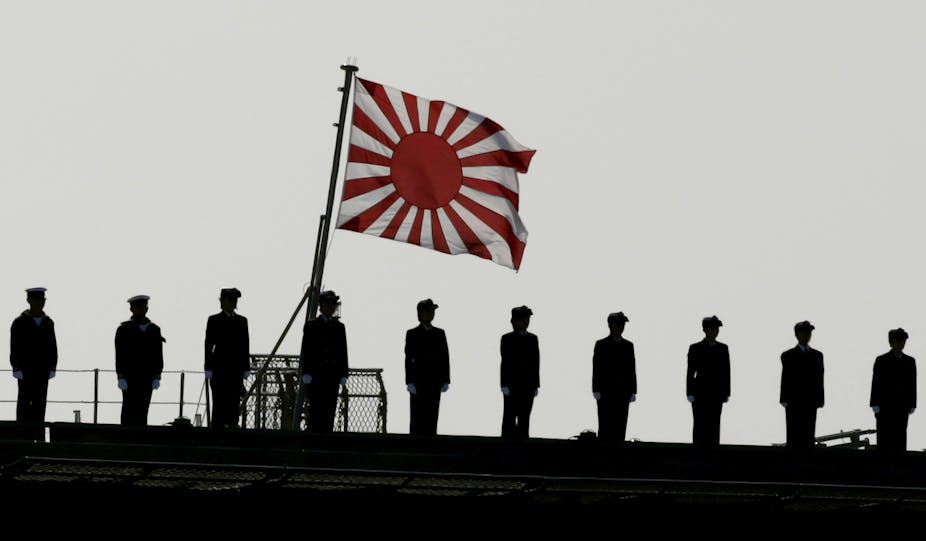The heads of state of the G7 countries are convening in Ise-Shima, Japan for their annual summit. They were preceded by their foreign ministers, whose meeting in Hiroshima in April produced a strongly worded statement on China’s “intimidating” and “provocative” military maneouvres in the East and South China Seas.
The tension in East Asia will hang heavy over the summit – and so will the host country’s response to it.
China’s behaviour has put new life into a fierce debate about Japanese militarism that’s been rumbling since the end of World War II. In March, controversial new military legislation passed by Shinzō Abe’s government at last came into effect. It authorises the Japanese Self Defence Forces to engage in “collective self defence” and to come to the aid of an ally under attack, thereby increasing the scope for Japanese military actions overseas.
According to its supporters, the legislation brings Japan into line with standard practice across the rest of the world, and allows the country to fulfil its international obligations, especially vis-à-vis its allies. In contrast, critics of the legislation argue that it directly contravenes Article 9 of Japan’s postwar constitution: “The Japanese people forever renounce war as a sovereign right of the nation and the threat or use of force as means of settling international disputes.”
In the Japanese context, the obligation to participate in “collective self defence” is commonly understood to refer specifically to the US. Critics of the Abe government’s new legislation are concerned that Japan could be compelled to go much further to help the US military, including participating in its ventures abroad.
Japan’s postwar international relations have been largely defined by its close relationship with the US. During its occupation of Japan in 1945-52, the US strove for complete disarmament of the defeated nation, as reflected in the so-called peace constitution that has been a battleground ever since its enactment in 1947. But total demilitarisation was soon abandoned under a policy known as the “reverse course”, which sought to rebuild and strengthen Japan as a bulwark against the spread of communism in East Asia.
Even after the end of the occupation, Japan was home to tens of thousands of US troops, and became an important staging ground and logistical base for American operations in the wars in Korea and Vietnam. Its Cold War-era strategic value to the US was described by a Japanese prime minister, Yasuhiro Nakasone, as akin to that of an “unsinkable aircraft carrier”.

At the same time, the US government allied with conservative Japanese politicians to drive a rearmament of Japan, initially so it could provide its own internal security. This resulted in the creation of the National Police Reserve in 1950, the forerunner of the Japan Self Defence Forces, founded in 1954.
Both of these organisations were arguably at odds with the constitution. But it was only in the late 1950s, as the US and conservative leaders pushed for further military buildup – including of nuclear weapons – that popular resistance to remilitarisation culminated in mass demonstrations.
The flashpoint was the extension and expansion of the US-Japan security treaty in 1959-60. In what was one of the largest popular protest movements in history, a reported 20m people joined protests against remilitarisation and the alliance with the US.
Although they haven’t stopped conservative moves towards remilitarisation, these protests continue to define Japan’s complex relationship with military issues. Both in Japan and overseas, the spectre of Japan’s old imperial militarism still looms large in discussions of military issues today.
‘Restore and strengthen’
Ever since the early postwar years, the argument has been fought by two sides. On the one hand is mass popular antipathy to remilitarisation and constitutional change; on the other is an alliance between the US government and conservative Japanese politicians with nationalistic agendas to “restore” and “strengthen” the nation’s pride.

The new military regulations of 2015-16, along with other militaristic measures that followed the 9/11 attacks, are a new turn in this debate. They were imposed against the wishes of the majority of Japanese by a minority of powerful conservative politicians gathered around Abe.
Although the vast majority of Japanese are too young to have personal memories of wartime and occupation, polls reveal that most harbour strong anti-war sentiments. Conscious of popular opinion, the Self Defence Forces have outwardly eschewed connections with the earlier imperial Japanese military, and tend to publicly portray themselves more as a disaster relief organisation than a military force.
The difficult relationship with the imperial period also extends to popular culture. A number of influential recent comics, animations, and films have espoused a revisionist history that relativises Japanese actions and portrays World War II as a selfless war for the “liberation” of Asia from European colonialism. These are very popular among the vocal and well-funded right-wing minority, which is especially active online.
The clash between an alliance of right-wing groups, conservative politicians, and US interests on the one hand, and the majority of Japanese and other East Asians who are wary of militarism on the other hand, shows no signs of abating.
And with North Korea still pursuing nuclear weapons and China antagonising its neighbours in the East and South China Seas, the Abe government sees every reason to press on with its militaristic agenda.

